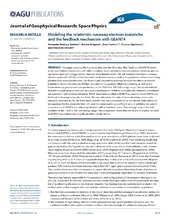| dc.contributor.author | Skeltved, Alexander Broberg | eng |
| dc.contributor.author | Østgaard, Nikolai | eng |
| dc.contributor.author | Gjesteland, Thomas | eng |
| dc.contributor.author | Celestin, Sebastien | eng |
| dc.contributor.author | Carlson, Brant Edward | eng |
| dc.date.accessioned | 2015-03-24T14:48:38Z | |
| dc.date.available | 2015-03-24T14:48:38Z | |
| dc.date.issued | 2014-11 | eng |
| dc.identifier.issn | 2169-9380 | en_US |
| dc.identifier.uri | https://hdl.handle.net/1956/9629 | |
| dc.description.abstract | This paper presents the first study that uses the GEometry ANd Tracking 4 (GEANT4) toolkit to do quantitative comparisons with other modeling results related to the production of terrestrial gamma ray flashes and high-energy particle emission from thunderstorms. We will study the relativistic runaway electron avalanche (RREA) and the relativistic feedback process, as well as the production of bremsstrahlung photons from runaway electrons. The Monte Carlo simulations take into account the effects of electron ionization, electron by electron (Møller), and electron by positron (Bhabha) scattering as well as the bremsstrahlung process and pair production, in the 250 eV to 100 GeV energy range. Our results indicate that the multiplication of electrons during the development of RREAs and under the influence of feedback are consistent with previous estimates. This is important to validate GEANT4 as a tool to model RREAs and feedback in homogeneous electric fields. We also determine the ratio of bremsstrahlung photons to energetic electrons Nγ/Ne. We then show that the ratio has a dependence on the electric field, which can be expressed by the avalanche time τ(E) and the bremsstrahlung coefficient α(ϵ). In addition, we present comparisons of GEANT4 simulations performed with a “standard” and a “low-energy” physics list both validated in the 1 keV to 100 GeV energy range. This comparison shows that the choice of physics list used in GEANT4 simulations has a significant effect on the results. | en_US |
| dc.language.iso | eng | eng |
| dc.publisher | Wiley | en_US |
| dc.rights | Attribution-NonCommercial-NoDerivs CC BY-NC-ND | eng |
| dc.rights.uri | http://creativecommons.org/licenses/by-nc-nd/4.0/ | eng |
| dc.subject | terrestrial gamma ray flashes | eng |
| dc.subject | lightning | eng |
| dc.subject | bremsstrahlung | eng |
| dc.subject | RREA | eng |
| dc.subject | TGF | eng |
| dc.subject | runaway relativistic electron avalanche | eng |
| dc.title | Modeling the relativistic runaway electron avalanche and the feedback mechanism with GEANT4 | en_US |
| dc.type | Peer reviewed | |
| dc.type | Journal article | |
| dc.date.updated | 2015-03-04T12:07:20Z | en_US |
| dc.description.version | publishedVersion | en_US |
| dc.rights.holder | Copyright 2014 The Authors | en_US |
| dc.identifier.doi | https://doi.org/10.1002/2014ja020504 | |
| dc.identifier.cristin | 1169631 | |
| dc.source.journal | Journal of Geophysical Research: Space Physics | |
| dc.source.40 | 119 | |
| dc.source.14 | 11 | |
| dc.source.pagenumber | 9174-9191 | |

